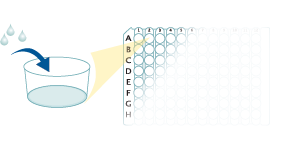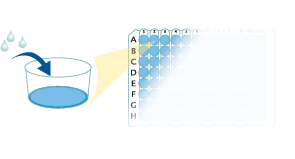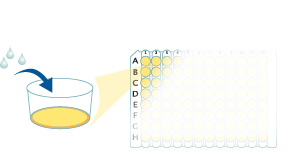Mouse IL-12 p40 NonAllele-specific Quantikine ELISA Summary
Product Summary
Precision
Cell Culture Supernates, Serum, EDTA Plasma, Heparin Plasma
| Intra-Assay Precision | Inter-Assay Precision | |||||
|---|---|---|---|---|---|---|
| Sample | 1 | 2 | 3 | 1 | 2 | 3 |
| n | 20 | 20 | 20 | 26 | 21 | 27 |
| Mean (pg/mL) | 33.3 | 56.4 | 397 | 36.5 | 62.7 | 405 |
| Standard Deviation | 2.3 | 3 | 17.2 | 3.8 | 6.5 | 33.7 |
| CV% | 6.9 | 5.3 | 4.3 | 10.4 | 10.4 | 8.3 |
Recovery
The recovery of mouse IL-12/IL-23 p40 spiked to three levels throughout the range of the assay in various matrices was evaluated.
| Sample Type | Average % Recovery | Range % |
|---|---|---|
| Cell Culture Supernates (n=4) | 104 | 98-108 |
| EDTA Plasma (n=4) | 99 | 81-112 |
| Heparin Plasma (n=4) | 95 | 80-109 |
| Serum (n=4) | 105 | 86-117 |
Linearity
Scientific Data
Product Datasheets
Preparation and Storage
Background: IL-12/IL-23 p40
Interleukin 12 (IL-12), also known as natural killer cell stimulatory factor (NKSF) or cytotoxic lymphocyte maturation factor (CLMF), is a heterodimeric pleiotropic cytokine made up of a 40 kDa (p40) subunit and a 35 kDa (p35) subunit. The IL-12 p40 subunit is shared by IL-23, another heterodimeric cytokine that has biological activities similar to, as well as distinct from, IL-12. IL-12 is produced by macrophages and B cells and has been shown to have multiple effects on T cells and natural killer (NK) cells. While mouse IL-12 is active on both human and mouse cells, human IL-12 is not active on mouse cells.
Assay Procedure
Refer to the product- Prepare all reagents, standard dilutions, and samples as directed in the product insert.
- Remove excess microplate strips from the plate frame, return them to the foil pouch containing the desiccant pack, and reseal.
- Add 50 µL of Assay Diluent to each well.
- Add 50 µL of Standard, Control, or sample to each well. Cover with a plate sealer, and incubate at room temperature for 2 hours.
- Aspirate each well and wash, repeating the process 4 times for a total of 5 washes.
- Add 100 µL of Conjugate to each well. Cover with a new plate sealer, and incubate at room temperature for 2 hours.
- Aspirate and wash 5 times.
- Add 100 µL Substrate Solution to each well. Incubate at room temperature for 30 minutes. PROTECT FROM LIGHT.
- Add 100 µL of Stop Solution to each well. Read at 450 nm within 30 minutes. Set wavelength correction to 540 nm or 570 nm.





Citations for Mouse IL-12 p40 NonAllele-specific Quantikine ELISA
R&D Systems personnel manually curate a database that contains references using R&D Systems products. The data collected includes not only links to publications in PubMed, but also provides information about sample types, species, and experimental conditions.
17
Citations: Showing 1 - 10
Filter your results:
Filter by:
-
CSF1R signaling is a regulator of pathogenesis in progressive MS
Authors: N Hagan, JL Kane, D Grover, L Woodworth, C Madore, J Saleh, J Sancho, J Liu, Y Li, J Proto, M Zelic, A Mahan, M Kothe, AA Scholte, M Fitzgerald, B Gisevius, A Haghikia, O Butovsky, D Ofengeim
Cell Death Dis, 2020-10-23;11(10):904.
Species: Mouse
Sample Types: Cell Culture Supernates
-
Human mesenchymal stem/stromal cells cultured as spheroids are self-activated to produce prostaglandin E2 that directs stimulated macrophages into an anti-inflammatory phenotype.
Authors: Ylostalo J, Bartosh T, Coble K, Prockop D
Stem Cells, 2012-10-01;30(10):2283-96.
Species: Mouse
Sample Types: Cell Culture Supernates
-
Cutting edge: Divergent cell-specific functions of MyD88 for inflammatory responses and organ injury in septic peritonitis.
Authors: Gais P, Reim D, Jusek G, Rossmann-Bloeck T, Weighardt H, Pfeffer K, Altmayr F, Janssen KP, Holzmann B
J. Immunol., 2012-05-14;188(12):5833-7.
Species: Mouse
Sample Types: Plasma
-
Modelling of mouse experimental colitis by global property screens: a holistic approach to assess drug effects in inflammatory bowel disease.
Authors: Gottfries J, Melgar S, Michaelsson E
PLoS ONE, 2012-01-18;7(1):e30005.
Species: Mouse
Sample Types: Tissue Homogenates
-
ChemR23 dampens lung inflammation and enhances anti-viral immunity in a mouse model of acute viral pneumonia.
Authors: Bondue B, Vosters O, de Nadai P, Glineur S, De Henau O, Luangsay S, Van Gool F, Communi D, De Vuyst P, Desmecht D, Parmentier M
PLoS Pathog., 2011-11-03;7(11):e1002358.
Species: Mouse
Sample Types: Tissue Homogenates
-
Serotonin activates dendritic cell function in the context of gut inflammation.
Authors: Li N, Ghia JE, Wang H, McClemens J, Cote F, Suehiro Y, Mallet J, Khan WI
Am. J. Pathol., 2011-02-01;178(2):662-71.
Species: Mouse
Sample Types: Cell Culture Supernates
-
Unc93B1 biases Toll-like receptor responses to nucleic acid in dendritic cells toward DNA- but against RNA-sensing.
Authors: Fukui R, Saitoh S, Matsumoto F, Kozuka-Hata H, Oyama M, Tabeta K, Beutler B, Miyake K
J. Exp. Med., 2009-05-18;206(6):1339-50.
Species: Mouse
Sample Types: Cell Culture Supernates
-
p47phox deficiency induces macrophage dysfunction resulting in progressive crystalline macrophage pneumonia.
Authors: Liu Q, Cheng LI, Yi L, Zhu N, Wood A, Changpriroa CM, Ward JM, Jackson SH
Am. J. Pathol., 2008-12-18;174(1):153-63.
Species: Mouse
Sample Types: BALF
-
NOD2-deficient mice have impaired resistance to Mycobacterium tuberculosis infection through defective innate and adaptive immunity.
Authors: Divangahi M, Mostowy S, Coulombe F, Kozak R, Guillot L, Veyrier F, Kobayashi KS, Flavell RA, Gros P, Behr MA
J. Immunol., 2008-11-15;181(10):7157-65.
Species: Mouse
Sample Types: Cell Culture Supernates
-
Pulmonary stromal cells induce the generation of regulatory DC attenuating T-cell-mediated lung inflammation.
Authors: Li Q, Guo Z, Xu X, Xia S, Cao X
Eur. J. Immunol., 2008-10-01;38(10):2751-61.
Species: Mouse
Sample Types: BALF
-
Cigarette smoke selectively enhances viral PAMP- and virus-induced pulmonary innate immune and remodeling responses in mice.
Authors: Kang MJ, Lee CG, Lee JY, Dela Cruz CS, Chen ZJ, Enelow R, Elias JA
J. Clin. Invest., 2008-08-01;118(8):2771-84.
Species: Mouse
Sample Types: BALF
-
Cytokine production by M-CSF- and GM-CSF-induced mouse bone marrow-derived macrophages upon coculturing with late apoptotic cells.
Authors: Yamazaki T, Nagata K, Kobayashi Y
Cell. Immunol., 2008-06-03;251(2):124-30.
Species: Mouse
Sample Types: Cell Culture Supernates
-
Toll-like receptor (TLR)2 and TLR3 synergy and cross-inhibition in murine myeloid dendritic cells.
Authors: Vanhoutte F, Paget C, Breuilh L, Fontaine J, Vendeville C, Goriely S, Ryffel B, Faveeuw C, Trottein F
Immunol. Lett., 2007-12-17;116(1):86-94.
Species: Mouse
Sample Types: Cell Culture Supernates
-
Oral administration of an immunostimulatory DNA sequence from Bifidobacterium longum improves Th1/Th2 balance in a murine model.
Authors: Takahashi N, Kitazawa H, Iwabuchi N, Xiao JZ, Miyaji K, Iwatsuki K, Saito T
Biosci. Biotechnol. Biochem., 2006-08-01;70(8):2013-7.
Species: Mouse
Sample Types: Cell Culture Supernates
-
The transcriptional response to lipopolysaccharide reveals a role for interferon-gamma in lung neutrophil recruitment.
Authors: Burch LH, Yang IV, Whitehead GS, Chao FG, Berman KG, Schwartz DA
Am. J. Physiol. Lung Cell Mol. Physiol., 2006-06-09;291(4):L677-82.
Species: Mouse
Sample Types: BALF
-
A novel siRNA-lipoplex technology for RNA interference in the mouse vascular endothelium.
Authors: Santel A, Aleku M, Keil O, Endruschat J, Esche V, Fisch G, Dames S, Loffler K, Fechtner M, Arnold W, Giese K, Klippel A, Kaufmann J
Gene Ther., 2006-04-20;13(16):1222-34.
Species: Mouse
Sample Types: Serum
-
Dendritic cells phagocytose and are activated by Treponema pallidum.
Authors: Bouis DA, Popova TG, Takashima A, Norgard MV
Infect. Immun., 2001-01-01;69(1):518-28.
Species: Mouse
Sample Types: Cell Culture Supernates
FAQs
-
What is the difference between the Mouse IL-12 p40 Allele-specific (M1240) and Non Allele-specific(MP400) Quantikine ELISA kits?
Polymorphisms exist in the mouse IL-12/IL-23 p40 sequence. The monoclonal capture antibody used in M1240 is allele-specific. It recognizes the IL-12/IL-23 p40 variant with methionine at residue 169 (Accession # P43432) in mouse strains A.SW, BALB/c, C3H, DBA/1, C57BL/6, NOR, and 129/J. The MP400 kit recognizes variant and non-variant mouse IL-12/IL-23 p40.
Reviews for Mouse IL-12 p40 NonAllele-specific Quantikine ELISA
There are currently no reviews for this product. Be the first to review Mouse IL-12 p40 NonAllele-specific Quantikine ELISA and earn rewards!
Have you used Mouse IL-12 p40 NonAllele-specific Quantikine ELISA?
Submit a review and receive an Amazon gift card.
$25/€18/£15/$25CAN/¥75 Yuan/¥2500 Yen for a review with an image
$10/€7/£6/$10 CAD/¥70 Yuan/¥1110 Yen for a review without an image








